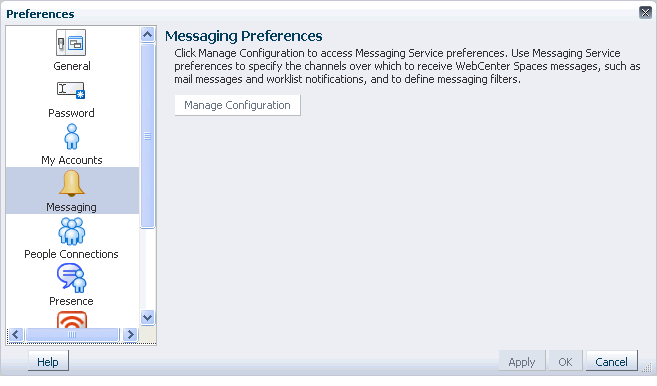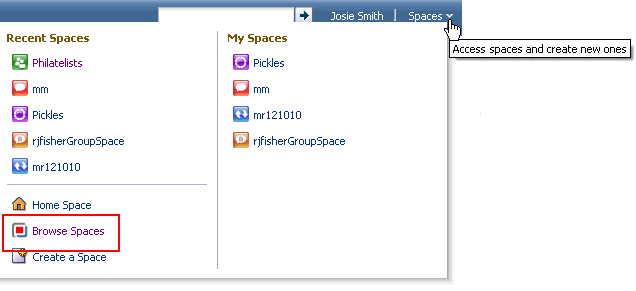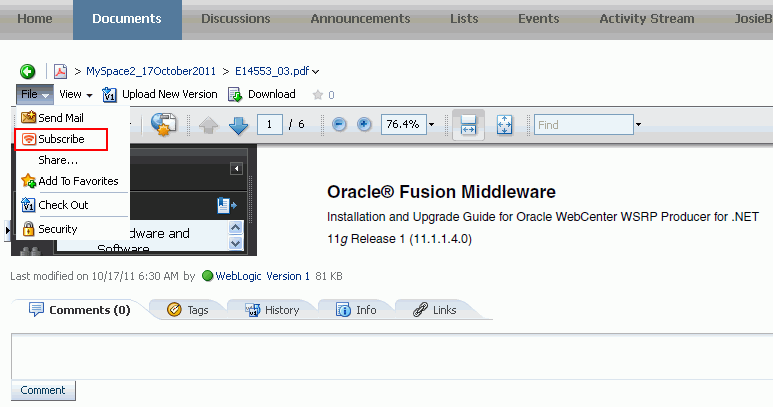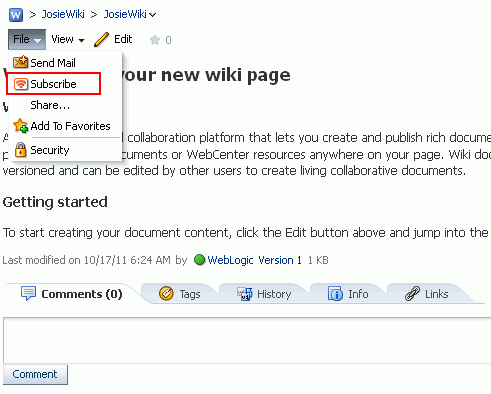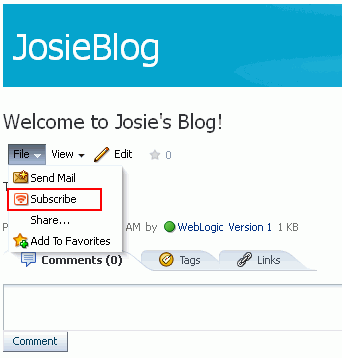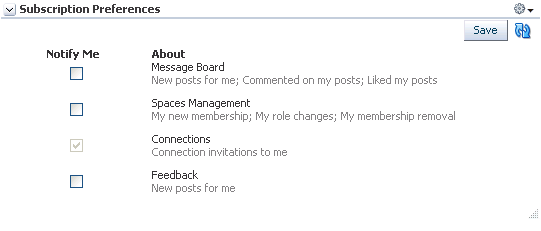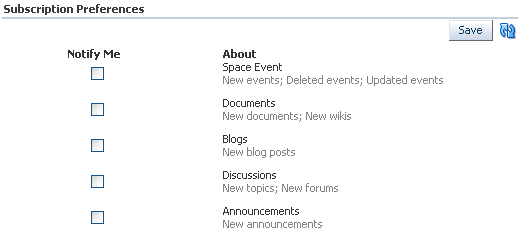36 Setting Up Your Personal Subscriptions and Notifications
Use Subscriptions and Notifications to receive timely notice of changes to your portal and to content surfaced through your portal. Track changes that occur to your connections, your space memberships, and services scoped to specific spaces and to the application objects that are important to you. Specify how you are notified: through phone text, mail, or your Worklist.
This chapter describes how to subscribe and unsubscribe to spaces and application objects, specify how you are notified when they are changed, and manage your subscriptions.
This chapter includes the following sections:
-
Section 36.1, "What You Should Know About Subscriptions and Notifications"
-
Section 36.2, "Establishing and Managing Your Messaging Channels and Filters"
-
Section 36.3, "Subscribing at the Application, Space, and Object Level"
This chapter is for users interested in being notified when changes occur to the spaces and application objects that are important to them.
Your application administrator can enforce certain application defaults that prevent you from setting subscription and notification preferences for yourself. In such cases, you will be unable to perform some of the actions described in this chapter.
See Also:
For information about administrative settings associated with Notifications, see the chapter, "Managing Subscriptions and Notifications," in the Oracle Fusion Middleware Administrator's Guide for Oracle WebCenter Portal.
36.1 What You Should Know About Subscriptions and Notifications
Notifications provides an automated means of triggering notices across different messaging channels. Messages are triggered when the spaces and application objects to which you have subscribed change.
Messaging channels can include phone text, mail, or Worklist (depending on how your administrator has configured Notifications). For example, you can receive a mail message when a particular document changes, a text message when someone responds to a particular discussion topic, a Worklist alert when you receive an invitation to connect. All messages contain links that take you to the scene of the change.
You can choose the objects that trigger a notice by subscribing to them. In Spaces, there are three levels of subscription:
-
Application, which you can use to receive notices about changes to your space memberships, Message Board, Connections, and Feedback
Such notifications occur only for application-level activities that involve you as the user.
-
Space, for changes to a subscribed service, such as Events, Discussions, Announcements, Documents, and Blogs, that occur within the scope of a selected space
-
Object, for changes to the application objects to which you have specifically subscribed, such as a particular document, wiki, blog, and so on
Table 36-1 describes the types of activities that can trigger a notification and indicates the level and location of the associated subscription (for more information, see Section 36.3, "Subscribing at the Application, Space, and Object Level").
Note:
Owning an object, such as a document, wiki, or blog, does not automatically subscribe you to that object. You must explicitly subscribe to an object to receive subscription-related notifications about it, unless the administrator has set and enforced company-wide subscription defaults. For more information about object-level subscriptions, see Section 36.3.3, "Setting Object-Level Subscriptions."
Table 36-1 Activities that Can Trigger Notifications
| Activity | Level | Where to Subscribe |
|---|---|---|
|
A user sends you an invitation to connect Note: Out of the box, the option to send notifications for invitations to connect is enabled and is not end-user configurable. |
Application |
Preferences (for more information, see Section 36.3.1, "Setting Application-Level Subscriptions") |
|
Your space role changes, for example from participant to moderator |
Application |
Preferences |
|
You are added as a member of a space |
Application |
Preferences |
|
Your space membership is removed |
Application |
Preferences |
|
A user posts a message to your Message Board |
Application |
Preferences |
|
A user likes your Message Board post (messages explicitly set on a Message Board and not those added from Publisher to the Activity Stream) |
Application |
Preferences |
|
A user comments on your Message Board post (messages explicitly set on a Message Board and not those added from Publisher to the Activity Stream) |
Application |
Preferences |
|
A user posts feedback for you |
Application |
Preferences |
|
An announcement is created |
Space |
On the space, for example, from the Actions menu on a space in Browse spaces (for more information, see Section 36.3.2, "Setting Space-Level Subscriptions") |
|
A new event is created |
Space |
On the space |
|
An event is updated |
Space |
On the space |
|
An event is deleted |
Space |
On the space |
|
A new discussion topic is created |
Space |
On the space |
|
A new discussion forum is created |
Space |
On the space |
|
A new document is created or uploaded |
Space |
On the space |
|
A wiki document is created |
Space |
On the space |
|
A new blog entry is posted |
Space |
On the space |
|
A user replies to a discussion topic |
Object |
On the topic (for more information, see Section 36.3.3, "Setting Object-Level Subscriptions") |
|
A user comments on a discussion topic |
Object |
On the topic |
|
A user deletes a discussion topic |
Object |
On the topic |
|
A user comments on a document |
Object |
On the document |
|
A user likes a document |
Object |
On the document |
|
A user updates a document |
Object |
On the document |
|
A user deletes a document |
Object |
On the document |
|
A user comments on a wiki document |
Object |
On the wiki |
|
A user likes a wiki document |
Object |
On the wiki |
|
A user updates a wiki document |
Object |
On the blog entry |
|
A user deletes a wiki document |
Object |
On the blog entry |
|
A user comments on a blog entry |
Object |
On the blog entry |
|
A user likes a blog entry |
Object |
On the blog entry |
|
A user updates a blog entry |
Object |
On the blog entry |
|
A user deletes a blog entry |
Object |
On the blog entry |
You can establish your preferred messaging channels through the Messaging panel in the Preferences dialog (for more information, see Section 36.2, "Establishing and Managing Your Messaging Channels and Filters"). Additionally, you can use messaging preferences to create filters for the types of notifications you want to receive.
Messaging configuration is available when your application administrator selects a BPEL server as the connection type for outbound notifications. If the administrator selects a Mail server, the only available messaging channel is mail; consequently, you are neither required nor able to configure your own messaging channels when your administrator selects a Mail server as the connection type for outbound notifications.
See Also:
For information about administrative settings associated with Notifications, see the chapter, "Managing Subscriptions and Notifications," in the Oracle Fusion Middleware Administrator's Guide for Oracle WebCenter Portal.
Default settings for application-level subscriptions are configurable by the application administrator. This means that your initial view of application-level Subscription Preferences is determined by these administrator defaults. Application-level subscriptions appear on the General Subscriptions tab of the Subscriptions panel in the Preferences dialog (Figure 36-1).
For each functional area or service on the General Subscriptions tab, the application administrator controls two settings:
-
Is subscription enabled for the function or service?
-
Are users allowed to change the default setting?
The answers to these questions determine how and whether general subscription options appear on your view of the tab. Table 36-2 illustrates how administrator-level subscription settings affect the appearance of the General Subscriptions tab.
Table 36-2 Effect of Administrator Defaults on Subscriptions Preferences
| Subscription EnabledFoot 1 | User Can Change Default | Option in Preferences |
|---|---|---|
|
True |
True |
Rendered normally, checkbox checked |
|
False |
True |
Rendered normally, checkbox cleared |
|
True |
False |
Grayed out, checkbox checked |
|
False |
False |
Hidden, checkbox hidden |
Footnote 1 Rather than enabling or disabling the entire subscription capability, the subscription-enabled attribute merely sets the initial state of the preference option. For example, if subscription-enabled="true", then the associated subscription option is checked by default in Spaces' Preferences dialog. If subscription-enabled="false", then the associated subscription option is not checked by default in the dialog.
See Also:
For information about administrative settings associated with Notifications, see the chapter, "Managing Subscriptions and Notifications," in Oracle Fusion Middleware Administrator's Guide for Oracle WebCenter Portal.
You can view and delete all of your subscriptions from one location: the Current Subscriptions tab on the Subscriptions panel in the Preferences dialog (Figure 36-2).
Use the Subscriptions panel to view and manage all of your application-, space-, and object-level subscriptions. For more information, see Section 36.4, "Viewing and Cancelling Your Subscriptions."
36.2 Establishing and Managing Your Messaging Channels and Filters
Out of the box, your mail address is your default messaging channel, and, with no filters defined, a subscription is sufficient to trigger a notification, provided your administrator has configured the external application associated with the Mail server connection to contain shared credentials and provided mail is selected as the messaging default.
See Also:
For information about administrative settings associated with Notifications, see the chapter, "Managing Subscriptions and Notifications," in the Oracle Fusion Middleware Administrator's Guide for Oracle WebCenter Portal.
The administrator's selection of a mail server as the messaging default presupposes that the administrator has also established a connection with a mail server. Additionally, the external application associated with the mail server connection must contain shared credentials. For information about connecting to a mail server, see the chapter "Managing the Mail Service," in Oracle Fusion Middleware Administrator's Guide for Oracle WebCenter Portal.
Once you have subscribed to an application object, no additional configuration is required to receive a notification through your mail when that object changes.
However, if you want to receive notifications over your phone, through your Worklist, or via an alternate mail address, a little configuration is required. First you must establish a messaging channel. Then you must define a messaging filter. The channel identifies the delivery medium and its associated address (user ID, mail, or phone number). The filter refines the types of notifications you receive and sets the conditions under which a notification is triggered.
This section steps you through the process of setting up your messaging channels and filters. It includes the following subsections:
36.2.1 Accessing Messaging Configuration Settings
The Messaging panel in the Spaces application's Preferences dialog provides a Manage Configuration button for navigating to User Messaging Preferences.
User Messaging Preferences derive from the User Messaging Service.
See Also:
For information about the User Messaging Service, see the Oracle Fusion Middleware Developer's Guide for Oracle SOA Suite.
To access messaging configuration settings:
-
Open the Preferences dialog, and click Messaging to bring the Messaging panel forward.
-
Click the Manage Configuration button to open User Messaging Preferences login page.
Note:
The Manage Configuration button is active only when a BPEL server is configured with the Spaces application. Because the BPEL server provides notification features to services, the Manage Configuration button may be active even when your application administrator elects to use a mail server in lieu of a BPEL server for Notifications.
-
Log in to the User Messaging Server (this is not required if single sign-on is implemented).
This opens the User Messaging Preferences panel (Figure 36-3).
The Messaging Channels tab provides controls for creating and managing messaging channels and a view of all configured messaging channels, such as WORKLIST, EMAIL, and SMS. The EMAIL channel is always available. By default, it uses your email address from the LDAP identity store. If the WORKLIST driver is deployed by your application administrator, it is also automatically added for each user.
The Messaging Filters tab provides a means of defining the conditions under which you are notified and associating a messaging channel with a defined set of conditions.
For information about messaging configuration, see the following subsections:
Note:
In environments where multiple BPEL connections are registered against the WebCenter Portal's Worklist component, the messaging preferences repository is shared by all. When you set messaging preferences for one connection, you set them for all.
36.2.2 Establishing a Messaging Channel
Establishing a messaging channel involves selecting the channel over which a notification is sent and providing the delivery address for that channel.
To establish a messaging channel:
-
Go to the User Messaging Preferences page as described in Section 36.2.1, "Accessing Messaging Configuration Settings."
-
If necessary, click the Messaging Channels tab to bring it forward.
-
Click the Create icon to open the Add Channel dialog (Figure 36-4).
-
In the Name field, enter a display name for the channel.
For example, enter
MyPhone. -
From the Type list, select the channel over which to send notifications:
Tip:
The presence of a channel is determined by the application administrator, who deploys them and makes them available.
-
EMAIL to specify that notifications are sent to you through your mail
-
SMS to specify that notifications are sent as text messages to your phone
-
WORKLIST to specify that notifications are posted to your Worklist
-
-
In the Address field, enter an address for the selected type:
-
For EMAIL, enter the address of the mail account to which to send notifications, for example,
my.name@mycompany.com. -
For SMS, enter the phone number to which to send notifications in the format
<country_code><area_code><number>, for example, 14154444444. -
For WORKLIST, your user name is provided as a read-only value.
-
-
For the Default checkbox:
-
Select to identify one or more channels as the default channel over which to send notifications.
Default channels are the channels over which are sent all notifications that do not meet any of your defined filtering conditions.
-
Clear to prevent selected channels from being used as defaults.
-
-
Click OK to save your changes and exit the dialog.
To complete your configuration, see Section 36.2.5, "Creating and Applying Messaging Filters."
36.2.3 Editing a Messaging Channel
To revise messaging channel values:
-
Go to the User Messaging Preferences page as described in Section 36.2.1, "Accessing Messaging Configuration Settings."
-
If necessary, click the Messaging Channels tab to bring it forward.
-
Select the messaging channel you want to revise, and click the Edit icon to open the Modify Channel dialog.
-
Change values as desired.
-
Click OK to save your changes and exit the dialog.
36.2.4 Deleting a Messaging Channel
When you delete a messaging channel, any filters that rely on the deleted channel revert to the channel identified as the default. In the absence of a specifically identified default channel, the mail channel is used for sending notifications.
To delete a messaging channel:
-
Go to the User Messaging Preferences page as described in Section 36.2.1, "Accessing Messaging Configuration Settings."
-
If necessary, click the Messaging Channels tab to bring it forward.
-
Select the messaging channel you want to delete, and click the Delete icon.
-
Click OK in the resulting Confirmation dialog.
36.2.5 Creating and Applying Messaging Filters
Messaging filters enable you to qualify the types of notifications you want to receive and weed out the notifications of no interest. Filters also provide a means of associating a selected messaging channel with a particular type of notification. For example, using messaging filters, you can specify that all notifications about document updates go to mail while all notifications about event changes go to your phone, provided your administrator has configured Notifications to use multiple messaging channels.
Two important things to know about setting up messaging filters:
-
Text values in your filtering conditions are case-sensitive. For example, messaging filters differentiate between Document and document.
-
Create separate conditions for multiple terms. For example, for a
Subjectthat contains Monty gave feedback, create three filtering conditions, one for each term.
To create and apply messaging filters:
-
Go to the User Messaging Preferences page as described in Section 36.2.1, "Accessing Messaging Configuration Settings."
-
If necessary, click the Messaging Filters tab to bring it forward.
-
Click the Create icon to open a filter-creation page.
-
In the Filter Name field, enter a display name for the filter.
-
Optionally, enter a filter description in the Description field.
-
From the Matching list, select from:
-
All of the following conditions to require that all of the conditions you specify are met
-
Any of the following conditions to require that at least one of the conditions you specify is met
-
-
From the first Add Filter Condition list, select from:
-
Subject to base a condition on words appearing in the message subject
It is likely that the most useful filter condition option is
Subject. The subjects of notification messages are standardized and can therefore be anticipated. This makes subjects ideal for setting up filtering conditions. See Table 36-4 for a list of standard notification message subjects and examples of filter conditions. -
From to base a condition on the message sender
All notification messages are sent from the same entity—as configured by your application administrator.
-
Date to base a condition on when the message was generated
DateandTimeoptions may be useful for ad hoc situations, for example, you want to ensure that any notifications about events delivered on the day of the event are sent right to your phone. -
Time to base a condition on the time the message was generated
Note:
Of all the filter conditions available on the Add Filter Condition list,
Subject,From,Date, andTimeare the options that are relevant to and work with the types of messages generated by Notifications. The other options have no effect. -
-
From the second Add Filter Condition list, select an operator for the condition.
See Also:
See Table 36-3 for an alphabetical list of operators that are relevant to the attributes
Subject,From,Date, andTime. -
Click the Click to add filter condition icon.
-
From the Messaging Option list, select from:
-
Send No Messages to omit notification for the defined filter conditions
-
Send Messages to all Selected Channels to send notification through all channels selected from the Add Notification Channel list
-
Send to the First Available Channel to send notification through the first open channel of all the selected channels
-
-
From the Add Notification Channel list, select the channel over which to send the notification messages that meet your defined filter conditions, and then click the Click to add channel to this filter icon.
The Add Notification Channel list is populated with the channels that are defined on the Messaging Channels tab. You can add multiple channels in turn.
-
Click OK to save and apply the messaging filter.
Tip:
If your defined filtering conditions do not match an incoming notification, the User Messaging Server will send notifications over all the channels you have identified as default channels.
Table 36-3 provides an alphabetical list of operators that are relevant to the attributes Subject, From, Date, and Time and describes the values they require.
Table 36-3 Operators relevant to Subject, From, Date, and Time
| Operator | ValueFoot 1 | Attributes |
|---|---|---|
|
|
In the fields provided:
|
Date, Time |
|
|
Enter a string that must be included in the message Subject or return address (From) Separate multiple values with commas. |
Subject, From |
|
|
Enter the literal value that must be used for the message Subject, Date, Time, or return address (From) |
Subject, From, Date, Time |
|
|
Enter the message delivery date beyond which to apply the filter |
Date |
|
|
Enter the message delivery date on which to start applying the filter |
Date |
|
|
Enter the message delivery date before which to start applying the filter |
Date |
|
|
Enter the message delivery date on which to stop applying the filter |
Date |
|
|
Enter a literal value that must be ignored for the message Subject, Date, Time, or return address (From) |
Subject, From, Date, Time |
|
|
No value is required. This operator applies to messages sent on weekdays. |
Date |
|
|
No value is required. This operator applies to messages sent on weekends. |
Date |
|
|
Enter a string that must be excluded from the message Subject or return address (From). Separate multiple values with commas. |
Subject, From |
Footnote 1 String values are case sensitive. Multiple values in strings must be separated by a comma.
Table 36-4 provides a list of standard notification message subjects and examples of condition formulations.
Table 36-4 Standard Notification Message Subjects
| Standardized Notification Subject | Example Filter Conditions |
|---|---|
|
|
|
|
|
|
|
|
|
|
|
|
|
|
|
|
Space Membership Change |
|
|
Note: For |
|
|
|
|
|
|
|
|
|
|
|
|
|
|
|
|
|
|
|
|
|
|
|
|
|
|
|
|
|
|
|
|
|
This example affects both created and deleted topics. Consider adding the verb, for example, created or deleted, in the filter condition when you want to make a distinction between the two types of actions. Note, however, that the verb alone is not likely to have the effect you want. For example, if you set the filter condition, |
|
|
|
|
|
|
|
|
|
|
|
|
|
|
|
|
|
|
|
|
On the day of the event, all notifications concerning the Java Summit event are routed to a selected channel. You can omit the term event, and receive other related notifications, such as an announcement concerning Java Summit. |
|
|
|
|
|
|
|
|
|
36.2.6 Editing Messaging Filters
-
Go to the User Messaging Preferences page as described in Section 36.2.1, "Accessing Messaging Configuration Settings."
-
If necessary, click the Messaging Filters tab to bring it forward.
-
Select the filter condition to edit, and click the Edit icon.
-
Make your changes.
-
Click OK to save and apply your changes.
36.2.7 Deleting Messaging Filters
-
Go to the User Messaging Preferences page as described in Section 36.2.1, "Accessing Messaging Configuration Settings."
-
If necessary, click the Messaging Filters tab to bring it forward.
-
Select the filter condition to delete, and click the Delete icon.
-
Click OK in the resulting Confirmation dialog.
Note:
You can remove a filtering condition without deleting the entire filter. Follow the steps in Section 36.2.6, "Editing Messaging Filters," and click the Delete icon next to the condition to remove.
36.3 Subscribing at the Application, Space, and Object Level
Where you perform a subscription varies according to the level at which the subscription is applied as well as the type of object being subscribed to. For example:
-
Application-level subscriptions are made through your personal preferences.
-
Space-level subscriptions are made on the space's Actions menu on the Browse Spaces page.
-
Object-level subscriptions are made on the object itself.
This section steps you through these subscription scenarios. It includes the following subsections:
36.3.1 Setting Application-Level Subscriptions
Set application-level subscriptions on the Subscriptions panel in the Preferences dialog (Figure 36-5).
You can use subscription preferences to specify whether to receive notifications from the People Connections service for activities related to Connections, Feedback, and Message Board. Additionally, you can use subscriptions preferences to subscribe to space management activities, such as changes to any of your space memberships or roles.
Application-level subscriptions are affected by the defaults set by the application administrator. In your view of Preferences, some subscription options may appear but be unavailable, while others may be hidden completely. For more information, see Section 36.1, "What You Should Know About Subscriptions and Notifications."
To set application-level subscriptions:
-
Open the Preferences dialog, click Subscriptions to open the Subscriptions panel, and, if necessary, click the General Subscriptions tab to bring it forward.
-
Select the checkbox next to an option for which to receive notifications through mail or other selected channels.
See Also:
For more information about messaging channels, see Section 36.2, "Establishing and Managing Your Messaging Channels and Filters."
Select from:
-
Message Board to receive notification when other users post messages to your Message Board, like your posts, and comment on your posts
-
Space Management to receive notification when you are added or removed as a member or your role changes
-
Connections to receive notification when another user invites you to connect
-
Feedback to receive notification when other users leave feedback for you
Clear the checkbox next to the options for which to omit notifications.
-
-
Click Apply to apply your changes and remain in the dialog; or click OK to save your changes and exit the dialog.
See Also:
For information about managing application-level subscriptions, see Section 36.4.1, "Viewing and Cancelling Application-Level Subscriptions."
36.3.2 Setting Space-Level Subscriptions
Subscribe to a space on the space's Actions menu on the Spaces page (Figure 36-6).
You can use space-level subscriptions to trigger notification messages whenever any of the following actions occur within the scope of the subscribed space:
To subscribe to a space:
-
Navigate to the Spaces page (Figure 36-7).
-
Right-click the space's icon or name, and select Contact and then Subscribe (Figure 36-8).
-
In the Subscribe dialog, select one or more of the following options:
Note:
An option appears in this dialog only when its associated service has been provided to the space. For example, if the space is not provided with the Discussions service, the Discussions option does not appear in this dialog.
-
Space Event, to receive notice whenever an event is created, updated, or deleted from this space
-
Documents, to receive notice whenever a document is created or uploaded to this space
See Also:
To see a more detailed level of notifications regarding a specific document, such as when it is updated, subscribe to the document at the object level. For more information, see Section 36.3.3.1, "Subscribing to a File."
-
Blogs, to receive notice whenever a blog entry is posted in this space
See Also:
To see a more detailed level of notifications regarding a specific blog entry, such as when it is edited, liked, or commented on, subscribe to the blog entry at the object level. For more information, see Section 36.3.3.3, "Subscribing to a Blog Entry."
-
Discussions, to receive notice whenever a discussion topic is created in this space
See Also:
To see a more detailed level of notifications regarding a specific discussion topic, such as when it is edited, liked, or commented on, subscribe to the topic at the object level. For more information, see Section 36.3.3.4, "Subscribing to a Discussion Topic."
-
Announcements, to receive notice whenever an announcement is created in this space
-
-
Click Save to save your settings and exit the dialog.
Once you have subscribed to a space, the subscription is reflected on the Current Subscriptions tab on the Subscriptions panel in the Preferences dialog. Here you can view all of your space- and object-level subscriptions. For more information, see Section 36.4.2, "Viewing and Cancelling Space- and Object-Level Subscriptions."
36.3.3 Setting Object-Level Subscriptions
You can use object-level subscriptions to trigger notification messages for actions performed on a selected document, wiki, blog entry, or discussion topic. This section describes how to subscribe to each. It includes the following subsections:
36.3.3.1 Subscribing to a File
When you subscribe to a file, whenever a user revises or deletes the file, or likes or comments on it, you are notified through your selected messaging channel.
See Also:
For more information, see Section 36.2, "Establishing and Managing Your Messaging Channels and Filters."
To subscribe to a file:
-
Go to the location where the file you want to subscribe to is listed.
-
Click the file link to open the file in the Document Viewer.
-
From the File menu, select Subscribe (Figure 36-9).
See Also:
For information about unsubscribing, see Section 36.4.2, "Viewing and Cancelling Space- and Object-Level Subscriptions."
36.3.3.2 Subscribing to a Wiki Document
When you subscribe to a wiki, whenever a user performs a major edit on, deletes, likes, or comments on the selected wiki, you are notified through your selected messaging channel.
Tip:
Users can identify a wiki document edit as major, in which case notification is sent. If the edit is not marked as major, no notification is sent.
To subscribe to a wiki:
-
Go to the wiki you want to subscribe to.
-
Open the File menu, and select the Subscribe option (Figure 36-10).
See Also:
For information about unsubscribing, see Section 36.4.2, "Viewing and Cancelling Space- and Object-Level Subscriptions."
36.3.3.3 Subscribing to a Blog Entry
When you subscribe to a blog entry, whenever a user edits, likes, comments on, or deletes the selected blog entry, you are notified through your selected messaging channel.
See Also:
For more information, see Section 36.2, "Establishing and Managing Your Messaging Channels and Filters."
To subscribe to a blog entry:
-
Go to the blog that contains the entry you want to subscribe to.
-
Click the link to the blog entry of interest to display its content.
-
From the File menu, select Subscribe (Figure 36-11).
See Also:
For information about unsubscribing, see Section 36.4.2, "Viewing and Cancelling Space- and Object-Level Subscriptions."
36.3.3.4 Subscribing to a Discussion Topic
When you subscribe to a discussion topic, whenever a user, edits, deletes, likes, or comments on the selected discussion topic, you are notified through your selected messaging channel.
See Also:
For more information, see Section 36.2, "Establishing and Managing Your Messaging Channels and Filters."
To subscribe to a discussion topic:
-
Go to the discussion topic you want to subscribe to.
-
Click the Subscribe link at the top of the topic (Figure 36-12).
See Also:
For information about unsubscribing, see Section 36.4.2, "Viewing and Cancelling Space- and Object-Level Subscriptions."
36.4 Viewing and Cancelling Your Subscriptions
Where you view and cancel your current subscriptions depends on the level of the subscription:
-
In addition to making application-level subscriptions, you can view and cancel application-level subscriptions on the General Subscriptions tab on the Subscriptions panel in the Preferences dialog.
-
View and cancel space- and object-level subscriptions on the Current Subscriptions tab on the Subscriptions panel in the Preferences dialog.
See Also:
The settings available on the Current Subscriptions tab are also provided through the Subscriptions Viewer task flow. For more information, see Section 36.5, "Working with Notifications Task Flows."
This section provides information about how to view and cancel your application-level subscriptions and how to view and cancel your space- and object-level subscriptions. It includes the following subsections:
-
Section 36.4.1, "Viewing and Cancelling Application-Level Subscriptions"
-
Section 36.4.2, "Viewing and Cancelling Space- and Object-Level Subscriptions"
36.4.1 Viewing and Cancelling Application-Level Subscriptions
View and cancel application-level subscriptions through Preferences or through the Subscription Preferences task flow (for more information, see Section 36.5, "Working with Notifications Task Flows").
To view or cancel application-level subscriptions:
36.4.2 Viewing and Cancelling Space- and Object-Level Subscriptions
Both space- and object-level subscriptions are listed in the Preferences dialog on the Subscriptions panel. Use the controls on the Current Subscriptions tab to adjust your view of these subscriptions and to cancel (or unsubscribe from) a space- or object-level subscription.
Tip:
Space- and object-level subscriptions can be cancelled through the same action you took to create the subscription. At the space- and object-levels, subscription options toggle between subscribed and unsubscribed. Follow the steps outlined in Section 36.3.2, "Setting Space-Level Subscriptions," and Section 36.3.3, "Setting Object-Level Subscriptions," but select to unsubscribe instead.
See Also:
The settings available on the Current Subscriptions tab are also provided in the Subscriptions Viewer task flow. For more information, see Section 36.5, "Working with Notifications Task Flows."
To view and cancel space- and object-level subscriptions:
-
Open the Preferences dialog, click Subscriptions to open the Subscriptions panel, and, if necessary, click the Current Subscriptions tab to bring it forward.
-
Use the View menu to control the display order of columns and to hide or show individual columns.
-
To cancel or unsubscribe from a space- or object-level subscription, select the subscription, and click Unsubscribe.
-
In the resulting Unsubscribe Notification Subscription dialog, click Unsubscribe.
The selected subscription no longer appears on the list of subscriptions.
-
Click OK to exit the Preferences dialog.
36.5 Working with Notifications Task Flows
The Notifications task flows duplicate the features provided through Notifications preferences, with the added benefit of flexibility. That is, you can place Notifications task flows on any page on which you have Edit permission. Additionally, the Subscription Preferences task flow changes scope according to where it is placed.
The options available through Notifications task flows duplicate those available in Subscription Preferences and in space-level subscription dialogs. These options are discussed in Section 36.3, "Subscribing at the Application, Space, and Object Level."
This section provides an overview of Notifications task flows and catalogs their associated task flow parameters. It includes the following subsections:
-
Section 36.5.1, "What You Should Know About Notifications Task Flows"
-
Section 36.5.3, "Setting Notifications Task Flow Properties"
36.5.1 What You Should Know About Notifications Task Flows
Two Notifications task flows are available through the Resource Catalog:
Note:
The content of the Resource Catalog is determined by the application administrator. For example, by default, the Subscription Preferences task flow is not available in the Resource Catalog, but your application administrator can add it. Consequently, it is documented here. For more information, see Section 16.3.1.2, "Adding Resources."
-
Subscription Preferences, which provides subscription options according to where its is placed:
-
A Subscription Preferences task flow on a Home space page provides application-level subscription options (Figure 36-13).
-
A Subscription Preferences task flow on a space page provides space-level subscription options (Figure 36-14).
See Also:
For information about controls for:
-
Application-level subscriptions, see Section 36.3.1, "Setting Application-Level Subscriptions," and Section 36.4.1, "Viewing and Cancelling Application-Level Subscriptions."
-
Space-level subscriptions, see Section 36.3.2, "Setting Space-Level Subscriptions," and Section 36.4.2, "Viewing and Cancelling Space- and Object-Level Subscriptions."
-
-
Subscription Viewer, which provides the same controls that are available on the Current Subscriptions tab of the Subscriptions panel in the Preferences dialog (Figure 36-15)
See Also:
For information about the controls that are available on the Current Subscriptions tab, see Section 36.4.2, "Viewing and Cancelling Space- and Object-Level Subscriptions."
36.5.2 Adding Notifications Task Flows to a Page
The process of adding a Notifications task flow to a page is the same for all task flows (for more information, see Section 17.5, "Adding Resource Catalog Components to Pages").
36.5.3 Setting Notifications Task Flow Properties
Notifications task flows have associated properties, which users with sufficient privileges can access through the Component Properties dialog in Composer (Figure 36-16)
See Also:
For information about accessing the Component Properties dialog, see Section 17.5.2.3, "Setting Component Properties."
The following sections provide information about properties associated with Notifications task flows and describe the properties available on the Parameters tab:
-
Section 36.5.3.1, "What You Should Know About Notifications Task Flow Properties"
-
Section 36.5.3.3, "Hiding Save and Refresh Actions on Subscription Preferences"
-
Section 36.5.3.4, "Displaying Subscription Controls for One Space in Another"
36.5.3.1 What You Should Know About Notifications Task Flow Properties
When you set property values on a Notifications task flow, you are affecting only the task flow instance on which the value is set. Other instances of the same task flow are not affected by such changes.
The properties on the Parameters tab of the Component Properties dialog can affect the default task flow content. For descriptions of the parameters on this tab, see Section 36.5.3.2, "Notifications Task Flow Parameters." For some task flows, parameters on this tab facilitate the wiring of the task flow to page parameters and page definition variables. For more information, see Chapter 19, "Wiring Pages, Task Flows, Portlets, and UI Components."
Changes to the properties on the Display Options, Style, and Content Style tabs affect the appearance and behavior of the task flow for all users. These properties are common to all task flows. For more information, see Section 17.5.2, "Setting Properties on Page Components."
The content of the Events tab depends on the events supported by the task flow. For more information, see Section 17.5.2.8, "Working with Component Contextual Events."
All properties on the Parameters and Display Options tabs provide access to an Expression Language (EL) editor, which you can use to select or specify a variable value instead of a constant value. Click the Edit icon next to a property field to open the editor. For more information about using the editor and for descriptions of common EL expressions, see Appendix B, "Expression Language Expressions."
Note:
Wherever you enter EL on the generic Display Options tab in the Component Properties dialog, the entry is automatically validated. If the EL is invalid, an error appears and the value is neither applied nor saved. Generic Display Options are those cataloged in Table 17-1.
EL validation is not performed on non-generic display options.
36.5.3.2 Notifications Task Flow Parameters
Table 36-5 describes the parameters that are unique to the Subscription Preferences task flow. The Subscription Viewer task flow does not have associated parameters.
Table 36-5 Subscription Preferences Task Flow Parameters
| Parameter | Description |
|---|---|
|
A control for showing or hiding the Save button and Refresh icon
|
|
|
The name of the space for which to display space-level subscription options Use the space internal name, available on the General Settings page under space Settings. The space internal name is at the end of the value in the space URL field. For example, in the following URL, the space internal name is http://myHost[...]/webcenter/spaces/standards |
36.5.3.3 Hiding Save and Refresh Actions on Subscription Preferences
The Subscription Preferences task flow has an associated parameter, named Hide Actions, that you can use to hide the Save button and Refresh icon on a selected task flow instance.
To hide the Save and Refresh actions on a task flow instance:
-
Go to the page that contains the task flow instance you want to change.
-
Open the page in edit mode.
-
Click the Edit icon (wrench) on the task flow header to open the Component Properties dialog.
-
Click the Parameters tab to bring it forward.
-
Click the menu icon next to Hide Actions, and select Expression Builder to open an Expression Language (EL) editor.
-
Select Type a value or expression, remove the current value in the field, and enter
#{true}. -
Click OK to exit the editor.
-
Click OK to exit the Component Properties dialog.
-
Click Save to save the page, and click Close to exit edit mode.
Tip:
To show the Save and Refresh actions, repeat the steps in this section, entering
#{false}in lieu of the current value.
36.5.3.4 Displaying Subscription Controls for One Space in Another
The Subscriptions Preferences task flow has an associated parameter, named Scope Name, that enables you to display the subscription options for one space in another space.
Scope Name can be handy in a few use cases. For example, normally, a Subscription Preferences task flow shows application-level subscription options when it is situated in the Home space. Instead, you could use Scope Name to control your subscription options for a particular space from the Home space. You could also set up a control center from which to control settings for various spaces from one location.
To display subscription controls for one space in another:
-
Go to the page that contains the task flow instance you want to change.
-
Open the page in edit mode.
-
Click the Edit icon (wrench) on the task flow header to open the Component Properties dialog.
-
Click the Parameters tab to bring it forward.
-
In the Scope Name field, enter the name of the space for which to display subscription controls.
Note:
Use the space internal name, available on the General Settings page under space Settings. The space internal name is at the end of the value in the Space URL field. For example, in the following URL, the space internal name is
standards:http://myHost[...]/webcenter/spaces/standards
-
Click OK to exit the Component Properties dialog.
-
Click Save to save the page, and click Close to exit edit mode.
Tip:
To change the instance to show subscription controls for the current scope, repeat the steps in this section, but remove the value in the Scope Name field.


